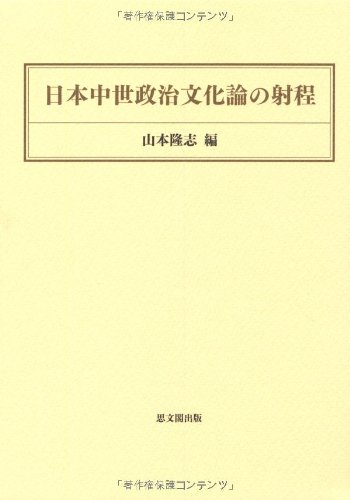2 0 0 0 OA 高野山宿坊史料の悉皆調査に基づく高野山子院と地方大名家との師檀関係の研究
本研究は、金剛三昧院・桜池院等の史料を調査することにより、高野山の宿坊史料の全体像を提示し、地方大名家の供養帳の史料的性格を明らかにし、大名家供養帳の成立と大名権力の確立との密接な関連性を考察することを目的とした。上記の研究のため、金剛三昧院については、平成23年度より経蔵内及び本堂に所在する史・資料の調査を行い、519点の供養帳を確認し、今まで存在が知られていなかった中・近世の多数の史料を確認した。桜池院については、諏訪・武田氏との関わりを中心としながら、調査を行い、中・近世の供養帳・新出文書を確認し、貴重な戦国期の供養帳に関しては、翻刻を行い、その史料的性格を明らかにした。
2 0 0 0 日本中世政治文化論の射程
- 著者
- 山本 隆志
- 出版者
- 校倉書房
- 雑誌
- 歴史評論 (ISSN:03868907)
- 巻号頁・発行日
- no.374, pp.p29-44, 1981-06
- 著者
- 山本 隆志
- 出版者
- 国立歴史民俗博物館
- 雑誌
- 国立歴史民俗博物館研究報告 (ISSN:02867400)
- 巻号頁・発行日
- vol.157, pp.83-105, 2010-03
荘園・村落に居住する百姓の生活は田畠耕作を基本としたが、それだけでない。地域の自然を自然に近い状態で利用し、生活の糧としてきた。このような地域的自然の利用・用益を「生業」と概念化し、そのあり方を歴史的にとらえようとすると、「中世史」という時代区分のなかだけで問題をとらえることは難しい。本稿では、葦と菱を事例にして、平安時代から江戸時代前期の史料に基づいて考察するものである。難波浦では浦の用益の一つとして葦苅取が平安期から盛んであり、都の需要と結びついて増大したが、個別の荘園や村落の排他的独占地域は設定されなかった。琵琶湖周辺では鎌倉期からの用益が認められるが、南北朝期には荘園領域に編入されており、奥嶋庄では百姓等が庄官と対抗しつつ自己の独占的排他的葦場を設定する。これが戦国期になると村の排他的葦場を確保する動きが多くなり、当該地域の舟運・漁業などの多様な用益を否定することになるが、多様的用益を求める郷・村の動きも強く、相論が恒常的となり、調停も日常的となり、場合によっては領主権力に依存することとなった。菱の用益も奈良・平安期から見られるが、平安後期の武蔵大里郡のように水害地に在地側が意図的に栽培することも見られ、農民の救荒的食料として期待された。戦国~江戸期には、尾張や摂津の湿地帯では、菱栽培が都市需要を見込んだ商品的作物として栽培された例が見られるが、菱を独占的排他的に栽培する菱場を設定するにはいたらなかった。葦・菱ともに浦や湖辺の湿地に用益が見られるが、それは湿地の多様な用益の一つとして進展するのであり、葦場として特化した用益地の設定には在地での抵抗が起こり、葦場は設定されても、限定的な方向が在地の相論・調停のなかで展開する。湿地用益は、特定の用益目的に限定される傾向にも向かうことは少なく、多様な主体と用益形態が展開しており、そうした方向が在地での相論・調停のなかで維持されてきた、と考えられる。「湿田」もこのような多様な用益形態の一つであろう。
1 0 0 0 三宅島 1983 年溶岩の冷却過程
- 著者
- 須藤 茂 阪口 圭一 松林 修 鎌田 浩毅 加藤 完 山本 隆志
- 出版者
- 特定非営利活動法人 日本火山学会
- 雑誌
- 火山.第2集
- 巻号頁・発行日
- vol.29, pp.S253-S265, 1984
Temperature measurements of the lava of 1983 in Miyake-jima in the Ako district were started fifty days after the eruption and have been continued since then. The following three kinds of temperature data have been obtained (Fig. 2). 1. Temperatures at 20 cm depth along a graveled temporary road on the clinkery surface of the lava using mercury and alcohol thermometers. 2. Temperatures at 0.5 to 2.5 m depth in iron pipes inserted into the clinker layer using thermocouples and mercury thermometers. The pipe holes were distributed along the temporary road and at scattered stations on the surface of the lava. 3. We drilled a borehole (DH-1) which penetrates through 5.5 m-thick lava into the previous ground. Temperature was measured at 10 points in the hole using thermocouples. For comparison, similar measurements in the Awabe district were made in pipes with depths up to 2.5 m (Fig. 3). These pipes were buried in the holes dug into the massive part of the lava for electric poles. The temperature data at 20 cm depth and in the pipe holes (Figs. 5-10) indicate that isothermal surfaces in the clinker layer are very complicated. This complexity is explained by rising plumes of hot vapor irregularly present in the lava field. The vapor is produced by degassing process in the massive part of the lava and comes up through newly formed cooling joints. Once a cooling joint is formed, the temperature of the massive part of the lava around the joint fell rapidly because a gas plume effectively transports the heat from the massive part to the surface. But the rate of temperature decrease varies greatly from one station to another. New plumes were formed sporadically and the temperatures of the new plumes were much higher than the decreased temperatures of the older plumes. Some older plumes died out because degassing process ended or the joints were self sealed by sublimates. It is necessary to arrange a number of observation stations and to add stations timely in order to reveal a cooling history of aa lava like the lava of 1983 in Miyake-jima. Around a plume, a convection cell was identified in the clinker layer (Figs. 16-18), which is similar to a hydrothermal convection system usually found in geothermal areas. The change of the temperature-depth profile of DH-1 with time (Figs. 11, 12) clearly shows that the lava heated the underlying previous ground. The peak shape of the profile has become broader and the depth of the maximum temperature has steadily fallen. The change of the temperature-depth profile also suggests that the upper clinker layer prevented rainfall from effective cooling of the massive part of the lava for the first 250 days. During that time, raindrops were evaporated in the clinker layer and did not reach the massive part below the clinker layer. Difference of cooling rate between Awabe lava and Ako lava may be due to the difference of the thickness of the clinker layers (Figs. 15, 19).
1 0 0 0 東国における武士勢力の成立と展開 : 東国武士論の再構築
1 0 0 0 OA 東国地域及び東アジア諸国における前近代文書等の形態・料紙に関する基礎的研究
- 著者
- 山本 隆志
- 巻号頁・発行日
- 2012
科学研究費助成事業(科学研究費補助金)研究成果報告書:基盤研究(A)2008-2011

